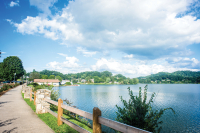To the bluffs: Two-year Alum Cave Trail project culminates
It’s a miraculously warm, blue-skied November day, the iconic Alum Cave Trail stretching smoothly from the trailhead.
The trail invites, almost audibly, framed by a mosaic of rhododendron, leafless deciduous trees and towering hemlocks that have thus far resisted the onslaught of the hemlock wooly adelgid. Tightly constructed wooden bridges and steps interject the trail’s leaf-and-dirt flooring, a stone drainage here and there waiting, shrouded with ferns, to siphon runoff from the trail when the drought finally ends.
Pursuing the Pinnacle: Mountain bikers push to create new trail system in Sylva
For the past decade, Sylva’s Pinnacle Park has had Sae Smyrl envisioning a lofty future for the hiking area. A mountain biker for the past 40 years, Smyrl would walk the trail and think how great it would be to ride his bike through the 1,100-acre forest. Bikes are allowed on the existing trail, but it’s way too steep for the sport to be fun.
A plan is now afoot to make Smyrl’s dream a reality, with the Nantahala Area Southern Off Road Bicycling Association pursuing a goal to bring some 30 miles of biking trail, featuring loops of various difficulty levels, to the Fisher Creek watershed.
Long live the hard copy trail guide
 Google the name of almost any trailhead in Western North Carolina, and you’re likely to come up with pages of links to a plethora of online mentions and trail descriptions aimed at helping readers do just the hike you’re looking for.
Google the name of almost any trailhead in Western North Carolina, and you’re likely to come up with pages of links to a plethora of online mentions and trail descriptions aimed at helping readers do just the hike you’re looking for.
Getting around town: Franklin focuses on making town more walkable
 Franklin has sidewalks, bike trails and a beautiful greenway to encourage residents and visitors to walk or bike around town, but those assets aren’t as valuable unless the town can find a better way to connect them.
Franklin has sidewalks, bike trails and a beautiful greenway to encourage residents and visitors to walk or bike around town, but those assets aren’t as valuable unless the town can find a better way to connect them.
Trail improvements coming to Fontana: Work begins on $380K trail project
 National forest trails around Fontana Village are in for an overhaul, thanks to a federal grant that’s putting the final piece in a years-long funding puzzle.
National forest trails around Fontana Village are in for an overhaul, thanks to a federal grant that’s putting the final piece in a years-long funding puzzle.
Between 2013 and 2015, the U.S. Forest Service has pulled in a total of $380,000 in grants to work on the area, but it’s just now getting going on the project the money was intended to support — 9 miles of upgraded trails in the Nantahala National Forest that will connect to the roughly 28 miles of trail that Fontana Village Resort, in Graham County, maintains on its own property.
Working for play: Trail groups pass forest stewardship to the next generation
 The woods are quiet on a cool Saturday morning in late March. There’s no wind swaying the still-bare trees or the rhododendrons clustered along streambeds. In this, one of the most remote trails of the Shining Rock Wilderness of Pisgah National Forest, the only sound comes from the occasional squirrel plowing through the bed of fallen leaves or bird sounding its call through the woods.
The woods are quiet on a cool Saturday morning in late March. There’s no wind swaying the still-bare trees or the rhododendrons clustered along streambeds. In this, one of the most remote trails of the Shining Rock Wilderness of Pisgah National Forest, the only sound comes from the occasional squirrel plowing through the bed of fallen leaves or bird sounding its call through the woods.
But then a soft buzz begins to float through the air. It pauses briefly, replaced by the sound of voices. A group of three is clustered around a fallen log, probably 2 or 3 feet in diameter, that’s lying across the faint path of the East Fork Trail. They analyze its position on the mountainside, its angle of contact with another trunk below the trail and the severity of the slope. Finally, trail crew volunteers Scotty Bowen and Richard Evans start up again with the crosscut saw, and the buzzing resumes.
Trail triage? Tough choices ahead as forest service weighs 1,600 miles in trail plan
 For the past year, the National Forest Service has been taking inventory, collecting public input and meeting with outdoor interest groups to wrangle its expansive web of nearly 1,600 miles of trail in the Nantahala and Pisgah national forests into a better, more sustainable network.
For the past year, the National Forest Service has been taking inventory, collecting public input and meeting with outdoor interest groups to wrangle its expansive web of nearly 1,600 miles of trail in the Nantahala and Pisgah national forests into a better, more sustainable network.
This month, the forest service will share its preliminary assessment from the “Trail Strategy Initiative” with mountain residents.
Scouting a Smokies Blueway Trail: Recreation abounds, but knowing where and how to tap it can be a mystery
 The mountains rising above the valleys have long been the main attraction for tourists planning a trip to Western North Carolina, but a regional initiative between local government and private entities is looking to capitalize on the recreational potential riding on the rivers beneath.
The mountains rising above the valleys have long been the main attraction for tourists planning a trip to Western North Carolina, but a regional initiative between local government and private entities is looking to capitalize on the recreational potential riding on the rivers beneath.
Volunteer crews troll the forests to keep trails clear
Next time you hike a trail, pause a minute and give silent thanks to the legion of trail volunteers who have taken up arms and engaged in hand-to-hand combat with the forest, hacking back the undergrowth and clearing obstructive logs.
Volunteer trail crews devoted 28,000 hours of labor in North Carolina’s national forests last year. It often seems like an uphill battle, with the earth constantly trying to reclaim the zigzag of footpaths cut through mountains, but so far crews are holding their own.
“The trails, I think, are really in good shape,” said Mary Gollwitzer, a hiker in Haywood County.
Before Gollwitzer leads a hike for her club — known as the Leisure Hikers — she makes a practice of scouting the trail ahead of time.
“I don’t like to all of a sudden lead a hike and never have gone on it myself. I stay away from that because I don’t know what to expect,” Gollwitzer said.
She might revise the hike plan if the trail is too steep or has large boulders to scramble over, but she’s never ruled out a hike for the club because of maintenance issues.
Volunteer trail crews make sure the cumulative mass of fallen limbs and downed trees don’t eventually overwhelm trails. They build back washed out bridges, repair eroding trail beds, fix soggy sections by diverting water from the trail, and cart out lots and lots of trash.
There are more than two dozen volunteer groups in the mountains that lend their sweat and muscle to take care of trails. The biggest is Carolina Mountain Club, which runs six volunteer trail crews that comb the mountains several times a week fixing problem spots on the trail.
“Our primary mission is to promote hiking in Western North Carolina, and of course, that means we need trails to hike on,” said Marcia Bromberg, president of Carolina Mountain Club.
Carolina Mountain Club logged 17,344 volunteer hours for trail maintenance in 2011, covering about 400 miles of trail.
Carolina Mountain Club is a stickler for detail when it comes to their trail work, approaching their maintenance reports with a level of notation and specificity you would expect from a NASA shuttle launch.
Some trail volunteers pack their handheld GPS unit, able to catalog the exact trouble spot.
“I observed a dead fall at E 36404, N 3946090 whose removal will require a later trip,” crew leader Wayne Steinmetz reported on a trail scouting trip.
Or, “I observed that ice covered the trail at E 365491, N 3946623 (WGS 83 horizontal datum).”
Their trail maintenance log from 2011 goes on like this — for 190 pages — detailing the who, what, when and how of more than 1,200 volunteer work outings held last year by their various trail crews.
“Hiked in from Sunburst on FS 97 and 97H. Cleared several simple downs, repaired tread at two wash locations and lopped rodies and beech sprouts along uphill side of trail,” Paul Dickens wrote in his report of a workday in the Middle Prong Wilderness in Haywood County last January.
Most trail reports are highly clinical in nature, but you can always tell when Becky Smucker’s come through. She can’t resist throwing in a line about the weather and her botanical findings of the day.
“We did a spring scout of Shining Creek Trail …We removed downs, lopped some, fixed some drainage, reworked one major tread problem, removed some fire rings and carried out a little trash. It was a gorgeous spring days, and giant Vasey’s trillium was in bloom,” Smucker wrote in one report from a workday near Cold Mountain in Haywood County last May.
Strength in numbers
Several volunteer trail groups have sprung up to take care of trails in a very specific area, such as Friends of Whiteside Mountain in Highlands, or of a particular trail, like the Bartram Trail Society or Benton MacKaye Trail Association.
One of these hyper-local groups is the Friends of Panthertown in the Cashiers area of Jackson County — a group united by their love for the place known as “Yosemite of the East.”
The idea of small-scale, local groups taking care of their own little slice of trails is a model the forest service would like to emulate in its quest to build a larger volunteer base, said Jason Kimenker, the director of Friends of Panthertown. The group, which numbers 350 members dedicated to the protection and preservation of Panthertown, has about three dozen trail volunteers who turn out for regular workdays.
In reality, a relatively minute percentage of hikers actually volunteer to work on trails. But adding more volunteers to the mix isn’t a simple solution, Bromberg said. Orchestrating trail crews is complicated and time consuming.
“There are various skill levels, everything from trained sawyers and people like me who go out with my loppers and that’s about the best that I’m going to be able to do,” Bromberg said.
While hikers constitute the vast majority of volunteers working on trails, mountain bikers have upped their presence considerably in recent years. Several mountain bike chapters hold regular trail workdays. They concentrate their efforts in popular mountain bike destinations, like Tsali, Bent Creek and DuPont State Forest.
Horseback groups have historically been the least represented in trail maintenance circles but have been pitching in more in recent years.
Where the forest service can’t keep up, “friends of various stripes have come in and taken a piece of the burden off them,” Bromberg said.
The Wilderness Society last year launched a trail crew to focus on maintenance specifically in national forest areas designated as “wilderness.” Wilderness areas are a challenge when it comes to trail maintenance because power tools aren’t allowed, which means no chainsaws.
The Southern Appalachian Wilderness Stewards uses a combination of volunteer and paid trail crews, with the help of a grant from the National Forest Foundation.
“It was birthed to take some of the pressure off the trail clubs, which found they couldn’t support more wilderness designations if they couldn’t take care of their trails,” said Brent Martin with The Wilderness Society’s Southern Appalachian field office in Sylva.
Program marries old skills with new needs
Scotty Bowman always knew he wanted to work outdoors, but he couldn’t figure out how to live his dream and also make a livable salary — so he instead paved a career in restaurants, including stints as a chef. At least, this is what Bowman did until hitting his 40s, that momentous time when folks often realize that it’s either now or never to indulge their passions.
Bowman, in taking the risk to build a new career focused on the outdoors, has become part of a unique movement that might just help the Southeast get more Wilderness Areas to enjoy. Bowman has been busy this summer building and fixing trails in remote backcountry settings with Southern Appalachian Wilderness Stewards, a new program of The Wilderness Society that works directly with the forest service to provide support for Wilderness Areas and Wilderness Study Areas.
In Wilderness Areas, you can’t use chainsaws or power tools for trail work, which makes building trails in the backcountry miles from the closest road tough work. The SAWS group is deploying volunteers into Wilderness Areas who are willing to do the heavylifting of trail work using only hand tools, such as crosscut saws, in those remote territories where firing up power tools would violate wilderness regulations.
The labor from SAWS crews not only blazes new trails and keeps existing ones maintained, they could also be key in the effort to get more areas in the national forests designated as wilderness.
Designating new wilderness areas can be controversial given the stricter rules that apply, limiting everything from motorized recreation to hunting to logging to road building.
But even hiking clubs can be against new wilderness designation if it means their volunteer efforts to maintain trails in those areas will become more difficult, explained Brent Martin, Southern Appalachian program director for the Wilderness Society’s, based out of the regional field office in Sylva.
Hiking clubs are the front line when it comes to trail maintenance. But, Martin pointed out, they are generally made up of older, retired folks, with small core groups who also work on trail maintenance. And with limited time and energy, these good Samaritans often understandably balk at the wilderness rule of not being allowed mechanized tools such as chainsaws.
Enter younger, eager men and women such as Bowman, who are simply enchanted with being able to use crosscut saws and other primitive tools. A volunteer stint with SAWS has led to a summer job for Bowman as head of a SAWS volunteer trail crew. He hopes to repeat the experience next summer.
The trail crews are trained in using the necessary primitive tools, and learn trail building and trail maintenance techniques.
Bowman is in college, and anticipates perhaps mingling the contacts made through SAWS into a more permanent outside-oriented job, such as with the U.S. Forest Service.
“I always wanted to be outside, to be a part of doing something for the trails and for the public,” the 42-year-old said. “And I’ve picked up some really cool skills doing this.”
And the wilderness areas are picking up a lot of extra maintenance help these days, said Bill Hodge, director of SAWS.
“The idea is not to replace the hiking clubs, it’s to supplement their work,” Hodge said.
In the Southern Appalachian region encompassing North Carolina, Georgia and South Carolina, there are 22 federally designated Wilderness Areas and another 14 Wilderness Study Areas, which fall under the same set of no-mechanized-tools restrictions. Wilderness Study Areas requires congressional approval to move into actual permanently protected Wilderness Areas.
Crews, such as the one led by Bowman, go into the backcountry for five-day stretches at a time to work on the trails. There have also been shorter, weekend-long programs. SAWS is also active through its Wilderness Rangers program, which has placed SAWS “rangers” on the Cherokee National Forest in east Tennessee and on the Chattahoochee National Forest in north Georgia through November.
The initiative is part of a wilderness challenge funding grant, a 10-year effort to bring all of the U.S. Forest Service’s wilderness units up to a certain standard by 2014. North Carolina’s Wilderness Areas were at a higher level this year, but since the areas are reassessed each year, it could be that a SAWS ranger will be used in this state next year, Hodge said.
The SAWS rangers are, along with other duties, helping map where camping sites are being set up in the wilderness areas, Hodge said. Plus, they often serve as the only “official” many visitors will see in these remote regions, helping to guide hikers and provide help as necessary.
SAWS also will hold its second Wilderness Skills College in partnership with the Appalachian Trail Conservancy with two weeks worth of trail techniques and crew-leadership training. This past spring the conference was at the Ocoee Ranger District Work Center in Ocoee, Tenn.
Next spring, the hope is to hold the workshops here in North Carolina, Hodge said.









